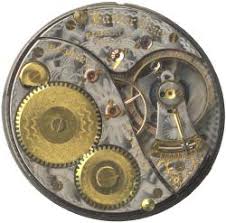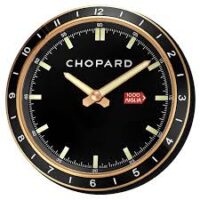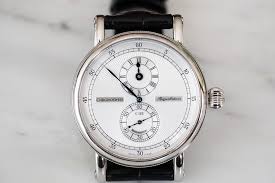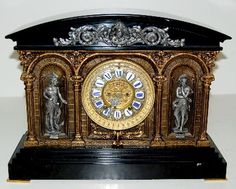








In the spring of 1864 half a dozen ambitious Chicago businessmen decided that if Massachusetts could build a factory that built watches – Illinois could, too. Harper’s magazine summed their sentiment perfectly: “It was the genuine, audacious, self-reliant Western spirit.” By August of that year this consortium, including then-Chicago mayor Benjamin W. Raymond, purchased an abandoned farm 30 miles north of Chicago and built a watch factory there. After a year of designing and building the lathes and machines to achieve seemingly impossible levels of precision, a team of watchmakers and mechanical engineers produced their first pocket watch movement, named for mayor “B.W. Raymond.” The watch was exquisite: Elgin National Watch Company was born.
By 1910, word of Elgin’s obsession with precision had spread around the world. Elgin engineers built their own Observatory to maintain scientifically precise times in their watches. Later, their accurate “wristlet” watches proved to be vital to the WWI war effort, helping to fuel a craze back in the states for something called “The Wrist Watch.” By the opulent Jazz Age, if you weren’t displaying the exuberant symmetry of an Elgin wrist watch or carrying a svelte, distinctive Elgin pocket watch, then who were you? Elgin had helped define the American pocket watch as unsurpassed in “Railroad Accuracy.” By 1930, the post Civil War dream factory imagined by a handful of American entrepreneurs had produced 32 million “time machines.”
During World War II, all civilian manufacturing was halted and the company moved into the defense industry, manufacturing military watches, chronometers, fuses for artillery shells, altimeters and other aircraft instruments and sapphire bearings used for aiming cannons.
While their altruism was vital to the war effort, Elgin’s patriotism ironically opened an opportunity for the Swiss. By 1964, after a Mid-Century decade that saw the rise of the elite “Lord and Lady Elgin” series, the original Elgin factory closed. Over the course of a century, the dream factory just north of Chicago had produced half of all jeweled pocket and wristwatches manufactured in the United States.
The legendary Elgin watch has become woven into the fabric of America:
Robert Johnson, pre-eminent Delta bluesman, sang “She’s got Elgin movements from her head down to her toes” in his 1936 recording of “Walkin’ Blues”.
NBA Hall of Famer Elgin Baylor was named after the Elgin National Watch Company.
Daniel Beard’s sketches of an angel at the end of A Connecticut Yankee in King Arthur’s Court are based on the Elgin National Watch Company’s logo.
The Steeleye Span album Bloody Men contains a track titled “Lord Elgin”: ostensibly a love song, it is, in fact, about the Lord Elgin Watch.
Elgin Watch Company is referenced in the video game L.A. Noire, which takes place in post-World War II Los Angeles.
Elgin was founded in 1864, right as the civil war was coming to an end. The first watch Elgin made, an 18 sized B W Raymond railroad grade watch, was finished in 1867 and over the next 100 years, they went on to produce about 60 million watches. Elgin produced their first wristwatch around 1910, leading most other American watch companies by many years.
Elgin was originally called the “National Watch Company”. The name never really stuck and in 1874, they changed their name to the “Elgin National Watch Company” because most of the watch trade and public were calling them “watches from Elgin”. They kept that name until the late 1960s when they stopped producing watches and changed their name to the “Elgin National Industries”.
Elgin was founded on the idea of mass producing high quality pocket watches using machine made, interchangeable parts. Up until around 1850, watches were made mostly by hand, which meant that if a part broke, you had to find someone with the tools and skill to make a new part. Gold Trimmed WatchElgin realized that there was a large market for good watches that could be sold and repaired relatively cheaply using factory made replacement parts that didn’t require hand adjusting.
Elgin never made the very highest quality watches in the world, nor did they make the very cheapest, but together with Waltham (aka The American Watch Company), they dominated the vast middle ground of the watch market.
Today, collecting Elgin watches is quite popular. Because Elgin produced so many watches and produced so many spare parts, they can still be easily bought and fixed, so even a 100 year old Elgin can be used, with care, on a daily basis. While mechanical watches can’t compete with quartz watches for accuracy, there is something about having a watch that ticks that a quartz watch just can’t replace.
Elgin:
The National Watch Company of Chicago, Illinois was incorporated on August 27, 1864 with a capital of $100,000. The incorporators were Philo Carpenter, Howard Z. Culver, Benjamin W. Raymond, George M. Wheeler, Thomas S. Dickerson, Edward H. Williams and W. Robbins.
In September of 1864 a visit was made by some company representatives to the Waltham Watch Co. and seven of their key people where lured away to work for the newly formed company and they were nicknamed the Seven Stars. The bait used was a $5,000 a year salary for 5 years, a $5,000 bonus and one acre of land on the company’s, soon to be acquired, 35 acre site (some things never seem to change). Since turn about is fair play, Elgin lost several of the Seven Stars to the Illinois Watch Co. a few years later in 1869.
The Seven Stars were all machinists first and watchmakers second. One of these men was Charles S. Moseley and he became the factory’s first superintendent. He had been in the watch business since 1852.
The Elgin businessmen had been informed that if they wanted the company to be located in Elgin they would have to donate 35 acres of land. The towns people would also have to put up $25,000 (keep in mind that the war was on and all the young men where gone). The requested location for the company was on a farm with absentee owners. The owners refused to sell unless the entire farm property of 71 acres was purchased at a price of $3,550. Four local businessmen purchased the land and donated the 35 acres. The company was re-organized on April 25, 1865 with a capitol of $500,000.
The first officers were:
Benjamin W. Raymond, President Philo Carpenter, Vice President Thomas S. Dickerson, Treasurer George M. Wheeler, Secretary
The first movement was delivered from the factory April 1, 1867 and was named in honor of Benjamin W. Raymond. It was an 18 size, key wind, and full plate, with quick train and straight-line escapement arranged to set on the face and was adjusted to temperature. At that time watches took six months to complete and the B. W. Raymond model sold for $117 at a time when pork chops sold for three cents a pound (several years ago this watch was bought at auction by the city of Elgin for $15,000).
On July 16, 1867, a new watch was made and it was named the H. Z. Culver. The slow train was then adopted on all the new movements brought out and they appeared on the market as follows; J. T. Ryerson, October 14, 1867; H. H. Taylor, November 20, 1867; G.W. Wheeler, November 26, 1867 and Matthew Laflin, January 2, 1868. (Laflin and Ryerson both sat on the Elgin’s board of directors and Laflin’s family did so for more than 70 years.)
On May 20, 1869 the first “Lady Elgin” made its appearance and was the first of a series of 10 size movements and it was also key wind. This was followed on August 24, 1870 by the Francis Rubie, which was adjusted to temperature, on September 8, 1871 by the Gail Borden (of Elsie fame) and on December 20, 1871 by the Dexter Street.
Elgin and most other watch companies sold their movements to wholesaler’s who then sold them to the jewelry shops. The customer would pick out the case of his choice, add the dial and then the jeweler would put them together. Only about 10% of the cases sold were solid gold.
The first stem wind movement was placed on the market June 28, 1873. It was a B. W. Raymond movement made over, and was followed shortly by the Culver, Taylor, Wheeler, Laflin and Ogden movements.
On May 12, 1874 during a special stockholder’s meeting held in Chicago, the name of the company was changed to “The Elgin National Watch Company. This was thought to be advisable because the movements manufactured by the company were universally known as and called “Elgin Watches” or the “Watch from Elgin”.
Seven new grades of 10 size, six grades of 12 size and five grades of 14 size, three quarter plate, key wind movements, were made by the company between September 29, 1875 and December 29, 1876. Most of these new patterns were made for the foreign markets, which demanded movements differing in some respects from those made for home consumption.
The company placed its first nickel movement upon the market, August 15, 1877. A new line of 8 size, stem wind watches were introduced on June 11, 1878, and in the fall of 1878 four grades of 16 size, three quarter plate, stem wind movements began production. These were interchangeable and could be used in hunting or open face cases and were considered quite a novelty at that time. These are called convertible models in today’s market and sell at a premium.
In 1888 the factory was producing about 7,500 movements per week, about one fifth of which were key wind and one tenth of the movements were nickel. The factory had 2,300 employees at this time and they were split 50/50 between men and women but not so their pay. The women earned about $6 per week while some of the men earned as much as $3 per day and this was for a 6-day workweek.)
During World War I the United States Army had the Elgin factory train more than 350 men to make the precision repairs required in the battlefields.
It was during the Second World War that all civilian work was stopped and Elgin made military watches, chronometers for the U.S. Navy, fuses for artillery shells, altimeters and instruments for aircraft and sapphire bearings used in the aiming of cannon. The Elgin Company was awarded ten Army-Navy “E” awards, for full filling contracts ahead of schedule.
The Elgin Company diversified after World War II making decorator clocks, transistor radios, wedding rings, but the heart’s beat was the Elgin watch. That heart beat had been getting slower every year and Elgin ceased to depend on the watch factory as its main enterprise. The clock tower of the National Street plant was torn down October 7, 1966.
The world’s largest watch manufacturing complex was located in several buildings from its inception in 1864 until the last Elgin movement made in the United States was completed in Elgin, South Carolina, in 1968.
Plant No. 1, the Main Plant, was located on National Street in Elgin, Illinois. The original building, opened in 1866, was expanded over the years. In 1925 it contained 583,343 square feet of floor space, the equivalent of 13.4 acres. This area was reduced to 454,800 square feet by 1947. The company sold it in 1965, and it was razed in 1965-66.
An observatory at 312 Watch Street, Elgin, Illinois, was constructed in 1909-10 to time watches by the stars. It was turned over to School District U46 in 1960.
The Elgin Watchmakers College, 267 South Grove Avenue, Elgin, was opened in 1921. The doors closed in 1960. The building was razed in 1985.
Plant No. 2 was located at 366 Bluff City Boulevard in Elgin, Illinois. Opened in 1925, it was acquired by the Elgin National Watch Company in 1940. In 1947 it had 64,930 square feet. No. 2 was closed in 1949 and re-opened in 1951. It was sold by Elgin National Industries in 1972, but a small watch repair operation continued to occupy it.
Plant No. 3 at 932 Benton Street, Aurora, Illinois. It was acquired for jewel production in 1942 and closed in 1950. In 1947 it contained 30,370 square feet.
The Lincoln, Nebraska, plant was purchased in 1945. It had 218,100 square feet in 1947. The operation was closed in 1958, and the building was sold to the University of Nebraska.
The Elgin, South Carolina, plant-a new building with 72,000 square feet of production space-was opened in 1963. It closed in 1968.
A leased plant at 1565 Fleetwood Drive, Elgin, Illinois, was occupied beginning in 1964 when operations were transferred from the obsolete Main Plant. Watch production was now centered in South Carolina, and this was the site of the casing, fitting, shipping, service, and trade material departments as well as offices. It was closed up about 1970.
From its inception, the company maintained its general offices in Chicago, Illinois. These were transferred to the Main Plant in Elgin in 1932 and 1940.
ELGIN SERIAL NUMBERS
Infomation contained above was obtained wth permission from Elgin enthusiast and collector
– Rusty Hanewacker –
Post note; currently, some companies are using the names of a classic (defunct) watch companies like Elgin, Benrus, Waltham, and Gruen to market new watches. They sometimes purchase the rights to the brand names, and other times they simply use the brand names of companies where the trademark has expired. These watches may hold the name, and are sonetimes styled exact replica’s of the original, but should not be confused with an orignal “vintage” watch. The watches are very different from the originals. Internally they use mostly quarz (battery) movements, instead of a mechanical one, and may not have the same quality or essence as the original. Please understand that I am not recommending against the purchase of these watches, only stating that the buyer should understand the difference.
Some info was taken from
Please remember that this is an unofficial account of the history of this company, Should you happen to find any mistakes with our information then please let us know at



